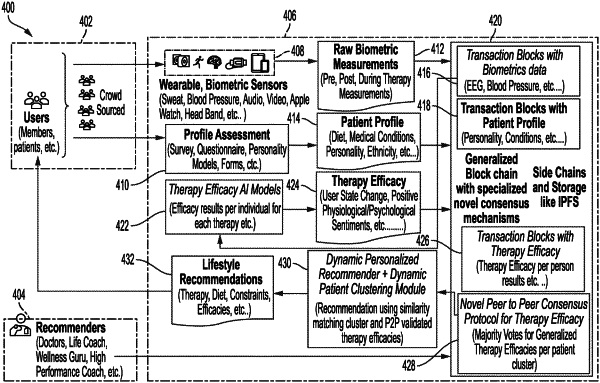| CPC G16H 20/70 (2018.01) [G06N 20/00 (2019.01); G16H 10/60 (2018.01); G16H 40/63 (2018.01); G16H 50/20 (2018.01); H04L 9/0643 (2013.01); H04L 9/50 (2022.05)] | 22 Claims |

|
1. A computing system comprising one or more processors and memory storing instructions that, with the one or more processors, configure the computing system to:
train, using a supervisory training function, a machine learning collaborative filtering model, using (i) a plurality of feature vectors corresponding to a plurality of user identifiers and (ii) known therapy efficacy data, to generate a trained machine learning collaborative filtering model;
receive, originating from an external computing device, a recommendation data object request, the recommendation data object request comprising a user identifier and one or more user attributes;
input the one or more user attributes into the trained machine learning collaborative filtering model;
generate, using the trained machine learning collaborative filtering model, one or more therapy identifiers associated with one or more therapy efficacy scores exceeding a therapy efficacy score threshold for one or more of the one or more user attributes;
provide, to the external computing device and in response to the recommendation data object request, a recommendation data object comprising one or more of the one or more therapy identifiers, causing the external computing device to provide, based at least in part on the recommendation data object, a therapy feedback object for generating a therapy efficacy transaction block for a distributed ledger, wherein the therapy efficacy transaction block comprises a therapy efficacy score for the user identifier and a therapy identifier; and
retrain, using a reinforcement learning function, the trained machine learning collaborative filtering model using (i) the plurality of feature vectors and (ii) a plurality of trusted efficacy blocks of the distributed ledger, wherein the plurality of trusted efficacy blocks is generated by:
generating, based at least in part on a therapy efficacy model, a plurality of therapy efficacy transaction blocks based at least in part on (i) a respective therapy efficacy score and (ii) one or more respective efficacy indication objects associated with each of a plurality of therapy identifiers, and
generating, based at least in part on an efficacy consensus protocol, a trusted efficacy block from the distributed ledger in response to a number of the plurality of therapy efficacy transaction blocks satisfying a therapy efficacy transaction block threshold.
|